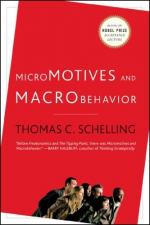
|
| Name: _________________________ | Period: ___________________ |
This test consists of 15 multiple choice questions and 5 short answer questions.
Multiple Choice Questions
1. What process does Schelling imagine parents choosing to undergo, in his hypothetical example?
(a) Community planning.
(b) Clairvoyance.
(c) Chromosome selection.
(d) Immunization.
2. What does Schelling say would be the consequence of a culture preferring male children?
(a) Shortage of workers.
(b) Influx of immigrants.
(c) Shortage of soldiers.
(d) Shortage of wives.
3. What does it mean if the median age is 45 in an open model?
(a) People over 90 will stay to be part of the group.
(b) People will stay until they move to nursing homes.
(c) Everyone under 35 and everyone over 65 will move out.
(d) Everyone under 25 and over 70 will move out.
4. How does Schelling predict nations will behave with regard to nuclear arms control?
(a) If one leads the others will follow.
(b) If there are terrorists anywhere in the world, nations will still maintain nuclear arsenals.
(c) If one decides to limit arms, the price of arms will go up.
(d) If arms are limited, other weapons will experience arms races.
5. What do hockey players fear in regard to the issue of wearing helmets, in Schelling's analysis?
(a) Fear of serious injury.
(b) Fear of seeming submissive to the league.
(c) Fear of inhibiting performance.
(d) Fear of ridicule.
6. What example does Schelling use to explain the closed system with a density enhancement?
(a) Distribution for a highway toll system.
(b) Distribution for local co-op market.
(c) Distribution for a university.
(d) Distribution for a nursing home.
7. In what war did Truman's successor have to decide whether to drop the bomb?
(a) Vietnam.
(b) The Korean War.
(c) The Falklands conflict.
(d) The Greek Civil War.
8. What does Schelling say would be at risk in a culture where parents preferred male children?
(a) Religion.
(b) Monogamous marriage.
(c) Safety.
(d) Cultural traditions.
9. What does Schelling say happens when the youngest ten percent of a population moves?
(a) There is a new "youngest" ten percent.
(b) The population is now considered more distributed.
(c) The old people are next to
(d) The average age of the group decreases.
10. How hockey players feel when the league makes helmets mandatory, in Schelling's analysis?
(a) Relieved.
(b) Rebellious.
(c) Resentful.
(d) Glad.
11. How is genetic modification different from eugenics?
(a) They are effectively the same.
(b) Eugenics allows for selection of more minute traits.
(c) Genetic modification is more subtle.
(d) Genetic modification theories have already led to ethnic cleansing.
12. What is a binary choice?
(a) A question of which thing of two things goes first.
(b) An either/or situation.
(c) A paradox.
(d) A lose-lose situation.
13. What does Schelling say would be the result of chromosomal selection that allowed parents to select for high-IQ children?
(a) Schools would not have to keep children until sixteen years of age.
(b) The incidence of social problems would increase, since intelligence and maturity are different variables.
(c) Parents would not have to work because their children would make more money and support them.
(d) The IQ range would yield a higher average IQ.
14. Under what condition would the population not be constrained by a mathematical identity after the youngest ten percent of a population moved away?
(a) The remaining people would have to be the same age.
(b) The young people would not be able to come back for visits.
(c) The people would still have to live within a reasonable distance.
(d) The remaining people would have to fill in the work the youngest people had done.
15. What does Schelling say are discrete variables?
(a) Sex, race and religion.
(b) Height, weight and eye color.
(c) History, ethnicity and tradition.
(d) Education, certifications and career.
Short Answer Questions
1. What does Schelling say about the "closed model"?
2. What has to happen before hockey players will accept the requirement to wear helmets, in Schelling's analysis?
3. What is another trait does Schelling say parents might be able to choose?
4. What additional factors does Schelling say contribute to population preferences?
5. What does Schelling say the British argued with the American when he was deciding whether to use the bomb?
|
This section contains 702 words (approx. 3 pages at 300 words per page) |

|




